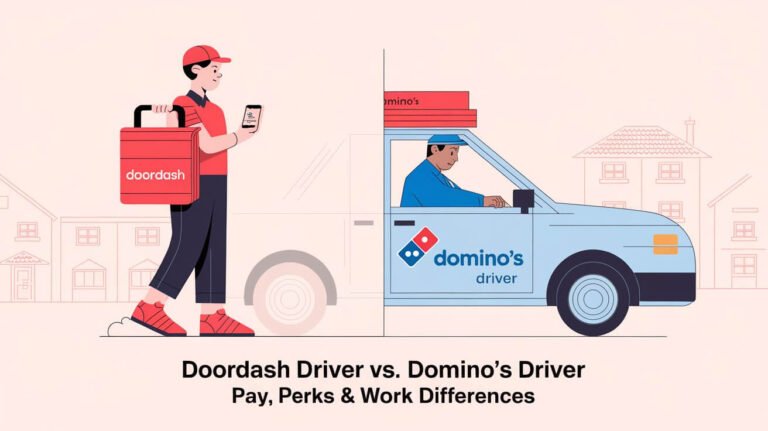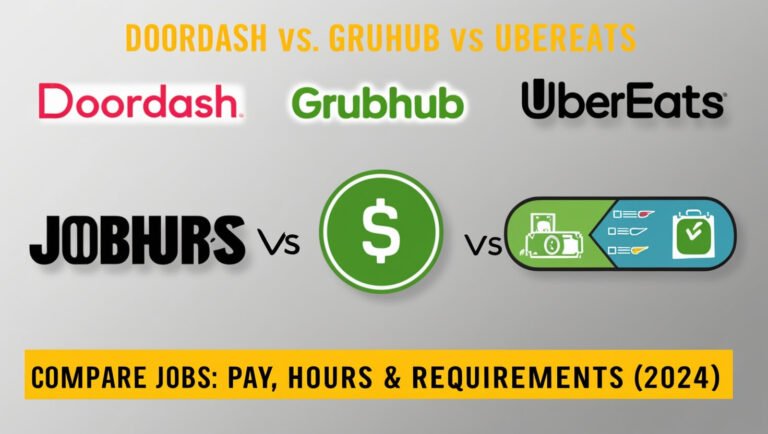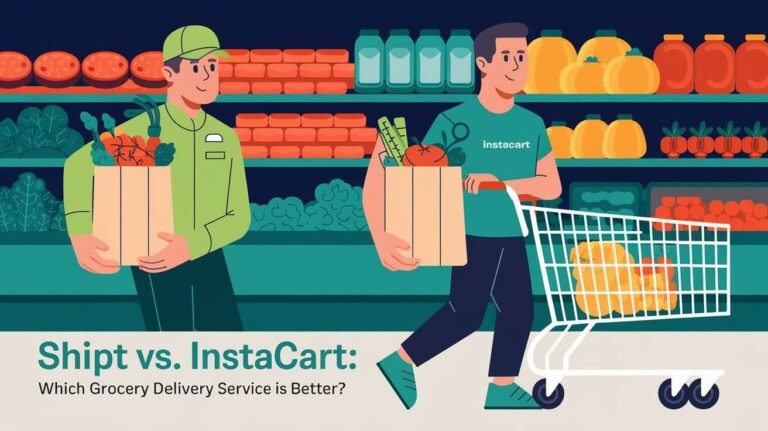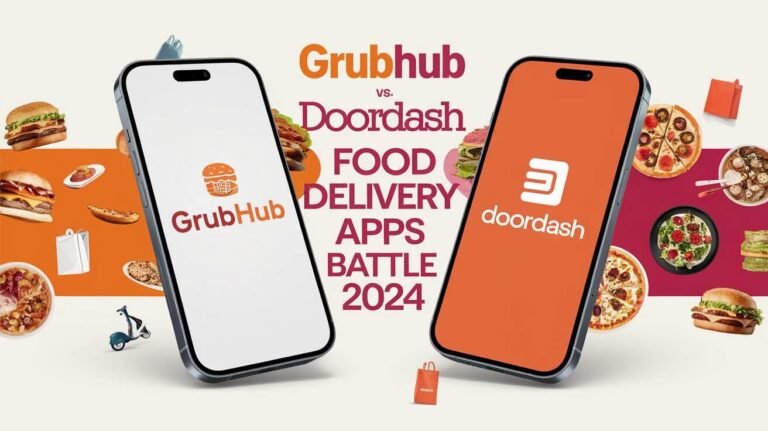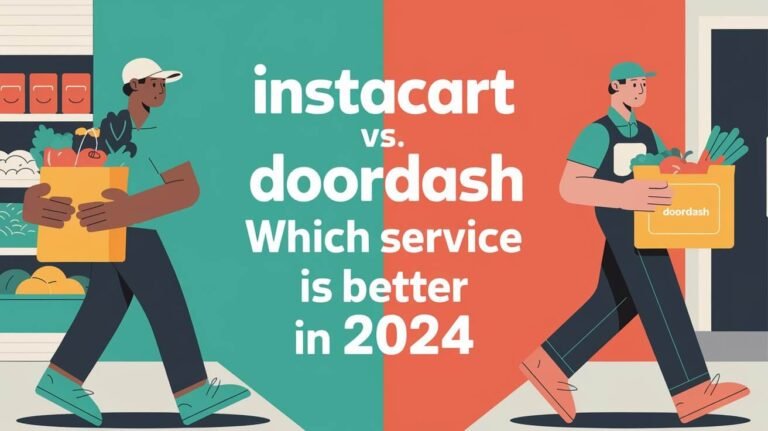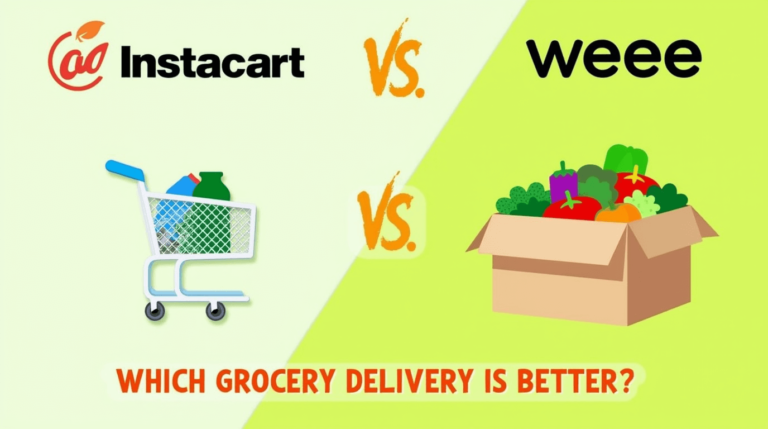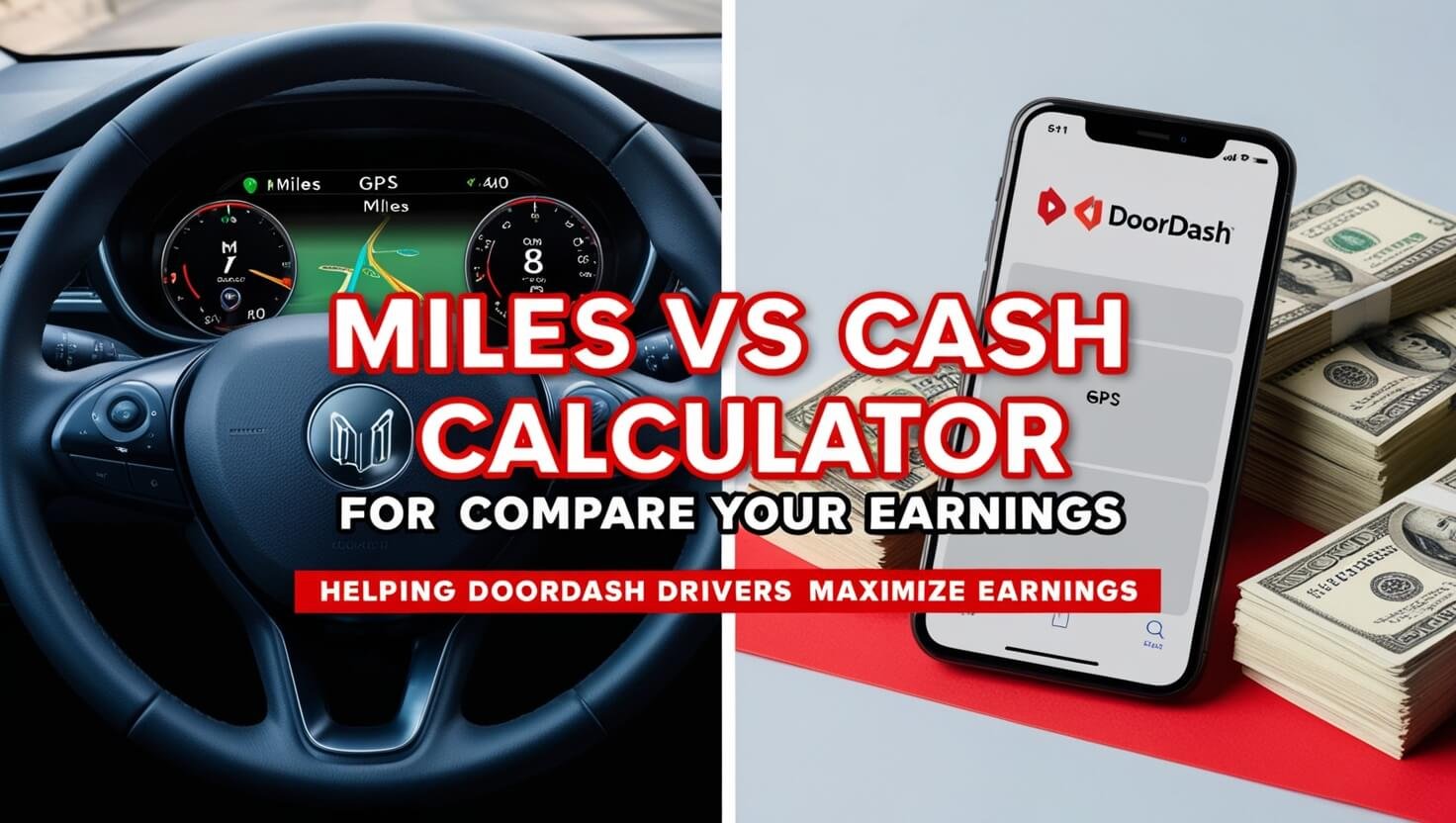
As a DoorDash driver, making the most of your earnings is vital. It’s important to know how miles driven and cash earned balance. By using tax write-offs, tracking expenses, and mileage deductions, you can increase your pay.
DoorDash drivers must report their income on Schedule C. They might get a Form 1099 showing their yearly earnings without taxes taken out. It’s crucial to keep records of vehicle expenses like gas, maintenance, and insurance. This helps you claim deductions and lower your taxes.
The IRS Mileage Rate for 2024 is 67 cents per mile. This can help you claim more deductions for DoorDash miles. Use apps like MileageWise, Stride, or MileIQ to track your trips. This way, you’ll have the proof you need to save on taxes.
Miles Vs Cash Calculator For Doordash Drivers
As a DoorDash driver, knowing how to balance miles and cash is key to making more money. A miles vs cash calculator helps you see your costs and earnings. This way, you can make better choices and increase your earnings.
For DoorDash deliveries, aim for at least $2 per mile. For quick orders, $1 might be okay, but avoid low-paying jobs unless they’re worth it. This includes Walmart grocery pickups and fast-food drive-thrus.
It’s important to track your miles and expenses. This helps you get the most tax deductions and understand your real earnings. Mileage tracking for gig work and using a side hustle income calculator can help you maximize your DoorDash driver profits. They help you find ways to work more efficiently and make more money.
“Dashers should save between 15-20% of their earnings for taxes, as they are self-employed 1099 contractors. The IRS only taxes business profits, not business revenue.”
Keeping detailed records and using the right tools, you can make the most of your DoorDash driving. This way, you can also reduce your taxes. Remember, the secret to maximizing doordash driver profits is to manage your miles, expenses, and earnings carefully.
Tax Write-offs and Deductions for DoorDash Delivery
As a DoorDash driver, you can enjoy many tax deductions. These can include vehicle costs, phone bills, and equipment expenses. They help lower your taxes and increase your earnings.
Vehicle-Related Tax Deductions
The standard mileage rate for DoorDash drivers in 2024 is $0.67 cents per mile. This covers gas, maintenance, repairs, and depreciation. If you use your vehicle for both work and personal trips, you can deduct the DoorDash miles.
Phone and Equipment Expenses
You can also deduct your phone and equipment used for DoorDash. This includes insulated bags and other tools. The deduction is based on how often you use them for work.
Insurance and Healthcare Deductions
As a self-employed DoorDash driver, you might deduct health insurance premiums. You must meet IRS rules. Roadside assistance and other job-related insurance costs are also deductible.
Keeping accurate records is key to getting the most from these deductions. Tools like Everlance can help track your expenses and mileage. This ensures you claim all eligible deductions.
Peak Hours and Prime Delivery Windows
To optimize doordash earnings and maximize delivery profits, DoorDash drivers need to know the food delivery peak hours. These times change by area but usually include busy periods like:
- 6 AM – 9 AM: Breakfast orders, for office catering and early birds
- 11 AM – 1 PM: Lunch rush, with lots of orders in downtown, tourist, and rich areas
- 5 PM – 9 PM: Dinner peak, busy in family spots and near schools
- 10 PM – 2 AM: Late-night deliveries, to colleges, clubs, and bars
Drivers should look at local data to find the best times. For example, in Los Angeles, weekday lunches are busy in Hollywood and downtown. Weeknight dinners are big in rich Westside areas. New York City sees a lot of office catering in the morning and family dinners in the evening.
Knowing these food delivery peak hours and prime delivery windows helps drivers plan. They can then maximize their earnings by working during the busiest times.
Strategic Scheduling and Zone Selection
As a DoorDash driver, you can earn more by choosing the right delivery zones and scheduling. Use advance booking, manage multiple zones, and find hotspots to boost your earnings. This way, you can work more efficiently and grab the best orders.
Advance Booking Techniques
DoorDash lets drivers book dashes up to six days early. This is great for busy areas. Booking ahead ensures you’re available when it’s busiest, helping you get more orders.
Multi-Zone Management
Being near many restaurants can get you more orders. Instead of staying in one place, try being in the middle of several. This “multi-zone management” boosts your efficiency and meets customer needs better.
Hotspot Analysis
Finding high-demand areas, or “hotspots,” is key. Look at order volume, customer density, and peak times to find the best spots. But don’t stay in one place too long. Switch between hotspots to keep earning well.
Using these strategies, DoorDash drivers can improve their doordash driver strategies, optimize delivery zones, and maximize their gig economy earnings.
Order Selection Criteria and Profitability
As a DoorDash driver, making the most of your delivery profits is crucial. Choosing the right orders is key. This helps you earn more and enjoy your work more.
Start by picking orders worth $7 or more. These high-value deliveries increase your earnings right away. They also help you make more money in the long run. Also, choose orders from well-known restaurants. They often give better tips and make deliveries smoother.
- Aim for orders with a minimum value of $7 or more
- Prioritize deliveries from popular and well-known restaurants
- Consider the distance, estimated time, and potential tips when accepting orders
Don’t get too caught up in accepting every order. Saying no to low-paying or long orders can actually help you earn more. By thinking carefully about each order, you can make choices that help you reach your goals. This includes making more money from your DoorDash work.
| Metric | Range |
|---|---|
| Earnings per Delivery | $8.25 – $8.50 |
| Tips as a Percentage of Total Earnings | 30% – 40% |
| Hourly Earnings | $15 – $22 |
| Average Daily Earnings | $110 – $140 |
| Base Pay per Delivery | $11 – $14 |
DoorDash drivers can optimize their earnings by strategically analyzing key performance metrics and selecting orders that maximize profitability. This helps them succeed in the fast-changing gig economy.
IRS Mileage Rate Benefits and Applications
The 2024 IRS mileage rate is now 67 cents per mile, up from last year. This change affects the tax deductions for DoorDash delivery drivers, or “dashers.” It’s key to track miles accurately to get the most from these deductions and increase earnings.
Current Rate Updates
The 2024 IRS mileage rate of 67 cents per mile accounts for higher vehicle costs. This includes fuel, maintenance, and insurance. DoorDash dashers can deduct business driving expenses using this rate, leading to more tax savings.
Calculating Mileage Deductions
DoorDash drivers can choose between the standard mileage deduction or actual expenses for taxes. The standard mileage deduction, based on the IRS rate, is usually easier and more beneficial for most. By using a reliable app like Everlance to track miles, dashers can maximize their tax deductions and improve their earnings.
Making smart use of the IRS mileage rate benefits can greatly boost the financial health of DoorDash delivery drivers. Keeping up with rate changes and using good mileage tracking tools are essential. They help dashers get the most from their tax deductions and increase their income.
Smart Route Planning and Efficiency
In the gig economy, planning delivery routes well is key to making more money and spending less. Drivers who plan their routes smartly can greatly improve their delivery route optimization and maximizing doordash efficiency.
Using navigation apps that plan multi-stop routes is a smart move. These apps help order the sequence of deliveries for the best route. They also help avoid busy roads during rush hours and find good parking spots. By grouping orders in the same direction and cutting down on backtracking, drivers can work more efficiently and earn more per hour.
- Utilize navigation apps that optimize multi-stop delivery routes
- Avoid traffic-heavy areas during peak hours
- Plan for convenient parking spots
- Group orders in similar directions to minimize backtracking
Good route planning saves time and cuts down on fuel and car wear. This makes a driver’s work more profitable. By getting better at these strategies, gig economy workers can manage their time better and earn more per hour.
Managing Vehicle Expenses and Maintenance
As a DoorDash driver, keeping your vehicle in good shape is key. It helps you avoid downtime and unexpected costs. A good preventive maintenance plan can keep you ahead and save you money.
Preventive Maintenance Schedule
- Regular oil changes: Keep up with oil changes to keep your engine running well and last longer.
- Tire rotations: Rotate your tires every 5,000-10,000 miles to make them wear evenly and last longer.
- Comprehensive inspections: Have your vehicle checked regularly to catch problems early.
Cost Tracking Methods
It’s important to keep track of your vehicle maintenance and other car expenses. This helps with accurate tax reporting and understanding your business costs. Use apps or spreadsheets to log all vehicle costs, like fuel, repairs, and maintenance. This info is crucial for tax time and saving money.
Taking care of your vehicle and tracking expenses, you can earn more and meet tax rules. Keeping your vehicle in good shape and managing costs is essential for success in the gig economy.
Automated Mileage Tracking Solutions
As a DoorDash driver, tracking your mileage and expenses can be a big hassle. Luckily, there are mileage tracking apps that make this easier. These doordash driver tools use GPS to log your trips and keep business and personal miles separate. They also create reports that meet IRS standards.
Everlance is a top choice, offering a 20% discount for DoorDash drivers on Premium. It has a high Apple iOS rating of 4.8 and a Google Play rating of 4.4. This makes it a reliable and easy-to-use option for tracking gig economy expenses.
| Mileage Tracking App | iOS Rating | Android Rating | Pricing |
|---|---|---|---|
| Solo | 4.7 | 4.5 | $10/month or $6/month with annual subscription |
| Stride | 4.8 | 3.5 | Free |
| Everlance | 4.8 | 4.4 | $60/year for Premium, $120/year for Premium Plus |
| Hurdlr | 4.6 | 4.5 | $100/year or $10/month for Premium |
| TripLog | 4.6 | 4.5 | Free up to 40 trips per report |
| MileIQ | 4.7 | 4.4 | $5.99/month or $60/year |
| SherpaShare | 4.4 | 4.0 | $5.99/month or $60/year |
| QuickBooks Self-Employed | 4.7 | 3.7 | Varies based on features |
Using these mileage tracking apps, DoorDash drivers can keep accurate records and get the most from their tax deductions. These tools automatically track trips, categorize expenses, and provide reports that meet IRS standards. They make managing your gig economy finances much easier.
Income Optimization Strategies
As a DoorDash delivery driver, making more money is crucial. DoorDash has many incentives and programs to help you earn more. By using these wisely, you can increase your DoorDash income.
Peak Pay Opportunities
DoorDash’s Peak Pay gives you extra money during busy times like meals and late nights. By choosing to work during these times, you can earn more for each delivery. DoorDash data shows Dashers work less than four hours a week. So, planning your time well can greatly increase your earnings.
Bonus Program Navigation
- DoorDash has bonus programs to encourage drivers, like challenges for a set number of deliveries.
- Knowing about these programs and planning your work can increase your earnings. Drivers can make between $17 and $24 an hour. Tips can raise this to up to $20 an hour.
- Keeping a high customer service rating and following instructions can also get you more tips. This boosts your income even more.
Strategic utilization of DoorDash’s peak pay and bonus programs can substantially enhance driver earnings in the gig economy.
Customer Service Excellence and Rating Impact
In the gig economy, keeping customers happy is key for DoorDash drivers, or Dashers, to make more money. By offering top-notch service, Dashers can earn more tips and boost their delivery ratings. This can open up more chances for them on the DoorDash platform.
Being careful with orders, following instructions well, and talking clearly are the basics of great service. Dashers should make sure food stays fresh and of good quality. Also, telling customers about any delays or problems helps keep their trust.
The Dasher Rewards Program rewards the best Dashers with benefits like getting to high-paying orders first. There are three levels: Silver, Gold, and Platinum. Each level offers more rewards as Dashers get better at their job, including higher customer ratings.
| Dasher Rewards Program Tiers | Key Benefits |
|---|---|
| Silver | Priority access to some high-paying orders, limited Dash Now priority |
| Gold | Enhanced priority on high-paying orders, improved Dash Now access |
| Platinum | Top priority on high-paying orders, Dash Now access regardless of demand, VIP support, access to large catering orders |
Keeping high customer ratings can lead to more chances and higher earnings for Dashers. This shows how vital it is to give excellent doordash customer service tips and keep improving delivery ratings. It’s all about succeeding in the gig economy customer satisfaction world.
Business Expense Documentation Methods
As a DoorDash driver, keeping track of your business expenses is key. It helps you get the most out of tax deductions and follow IRS rules. Using digital receipt tools makes it easier to manage your expenses. This way, you can avoid losing important documents and make tax time less stressful.
Digital Receipt Management
Mobile apps or cloud platforms can change how you handle receipts. They let you take photos of your receipts and tag them for easy sorting. This method keeps your records safe and organized, helping you prove your deductions if needed.
Expense Categorization
Sorting your expenses correctly is vital for tax savings. Things like car costs, like gas and maintenance, can be big deductions. So can insulated bags, phone bills, and part of your health insurance. Keeping your expenses organized helps you understand your business’s health better.

